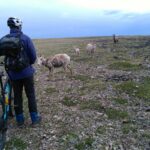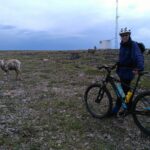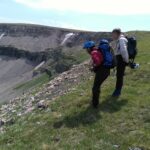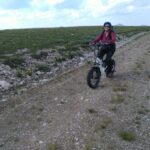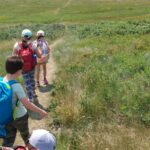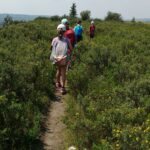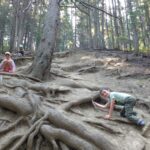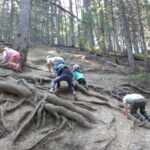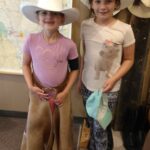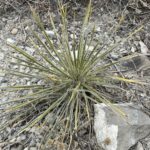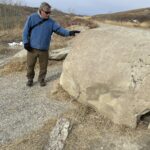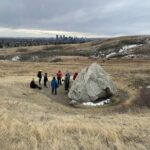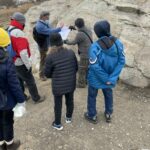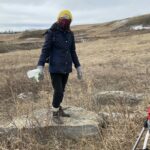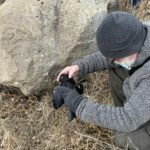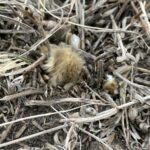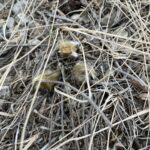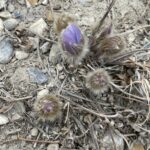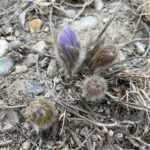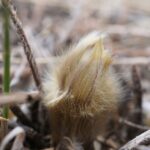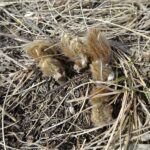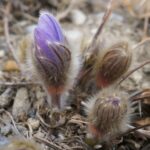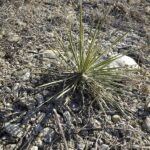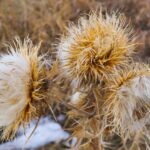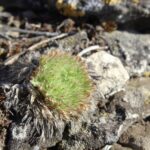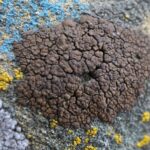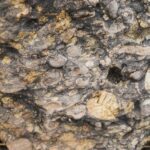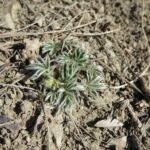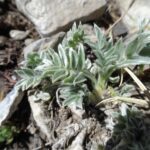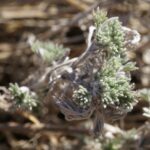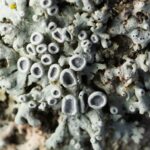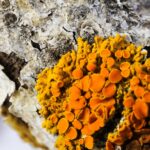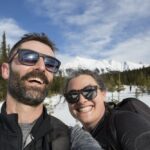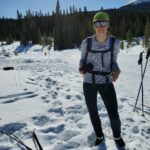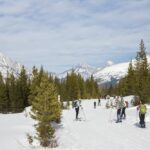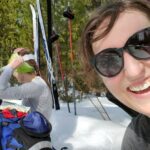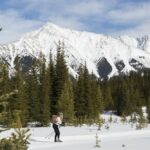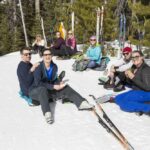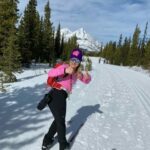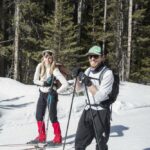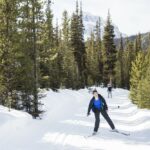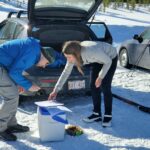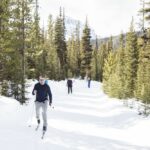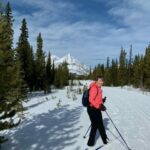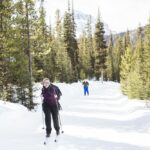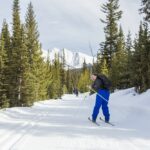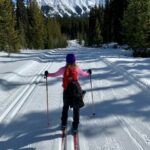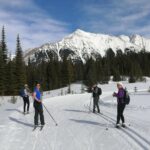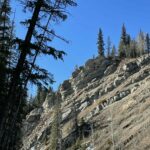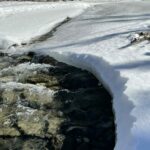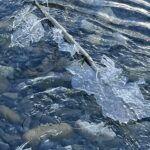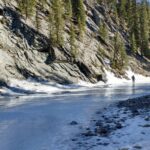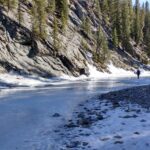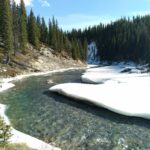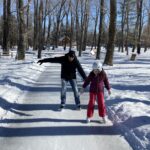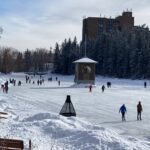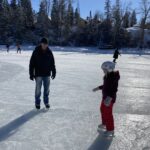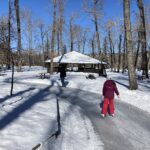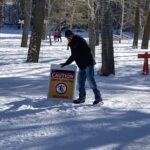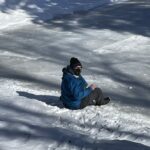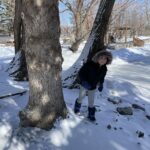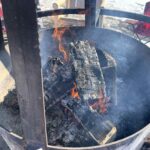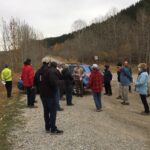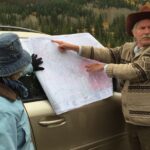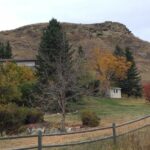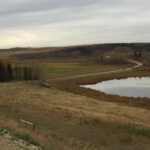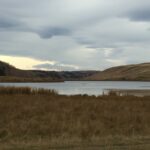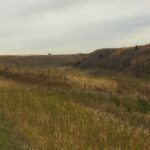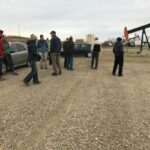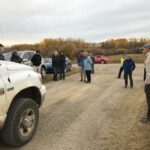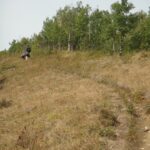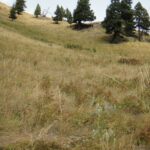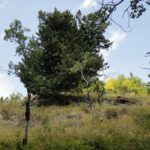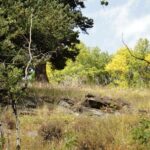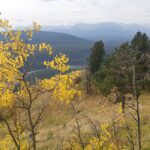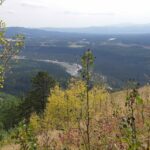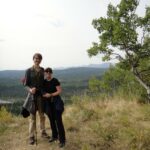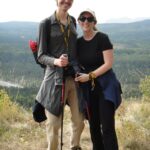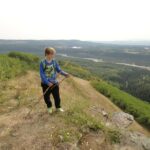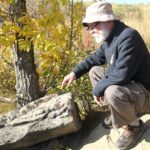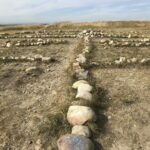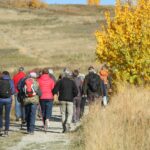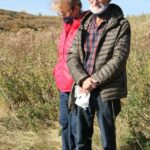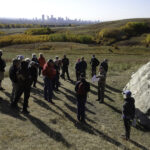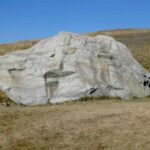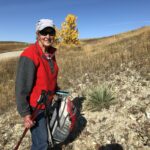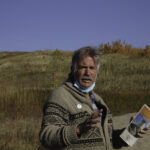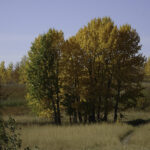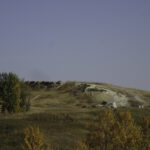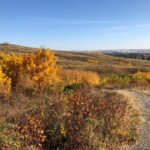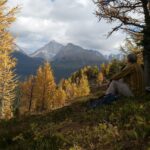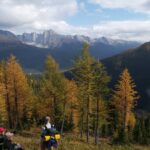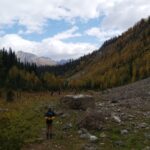Rewards Await Those who Persevere the Rain: Plateau Mountain Bike and Hike
Written on October 8, 2021, by Sean Nichols
The initially-inclement weather made the July 11 trip to Plateau Mountain a true Adventure! However as coordinator Chris Saunders relates, those who stuck with it were well rewarded:
Plateau Mountain is truly a gem in Alberta’s wild spaces inventory. There is a band of bighorn sheep that one can almost always count on seeing and almost always at this time of year, a bounty of alpine flowers in bloom. Today some rough spring weather made the rough road leading to the top of Plateau Mountain a bit of a struggle! However, at the top of the first ridge we walked through a flower meadow – the flowers were past their prime due to the early spring melt but the view was an impressive canyon overlook. The rain became heavier and the risk of serious lightning meant we thought we should shorten our visit to the top of Plateau Mountain, so the group cycled back to the gate and the safety of our cars. With a bit of patience we waited out the storm and the rain stopped and the clouds moved slowly to the south.
Those who had not given up on the day cycled back up the road with me. By the time we reached the top of the highest ridge the skies were blue and there was no evidence of the earlier rain. In cycling south along a road maintained by the oil and gas company that operates the two gas wells on the ridge, we encountered the band of bighorn sheep for whom the flat tundra terrain of the plateau is home. We stopped to see spectacular views off to the south east and south west at end of the ridge; as well as to the east in a middle section.
Cycling north along the ridge we were on an old road which is rapidly being naturalized and reclaimed by the vegetation. Here too the flowers, which at this time of year can be spectacularly beautiful, were past their best. On the return journey along this road we saw, within a few yards of us, a band of about 20 male bighorn sheep of differing ages: a wonderful sight.
The fast bike ride down from the plateau was negotiated safely and we got back to our cars for a safe drive home after a satisfying and physically challenging ride up and hike along Plateau Mountain.
Learning about Alberta’s Nature and History: Cochrane Ranche Adventure
Written on October 5, 2021, by Sean Nichols
On a warm and sunny July 22, Margaret O’Regan led several schoolchildren through Cochrane Ranche on a nature-filled adventure learning about Alberta’s history. Here’s how it went:
What could be better than time spent with a bunch of lovely kids hiking in a gorgeous valley, through the tall conifers with their gnarled roots, up along the ridges overlooking the valley, and spending time at a museum of western heritage (The Stockmen’s) that allows kids to touch everything, and even to try on cowboy hats, boots and chaps? In my books, it was a great adventure. From the kids’ point of view, I think it was pretty good too. They all seemed to have fun.
At the outset, equipped with magnifying glasses, they were very enthusiastic about checking out the finer details of flowers, leaves and seed heads, conifer needles, bark and lichen. They were eager, looked out for each other, and shared their discoveries with each other: the shimmering spider web, the water striders, slugs, insects, a dead bee (that was taken home by one young adventurer to be added to his collection of bees – dead ones), the insect that looked as pretty as a butterfly but lay its wings flat like a moth (a buttermoth perhaps?), the raven calls, and grasshopper chirrups, the feel of sticky tree sap, and the scent of wild thyme. They helped each other clamber up amongst the great roots of the tree known as the Grandfather Tree (why not Grandmother?), each one testing their own capacities; they got dirty, washed hands in the stream, chased uphill and down. At the museum, they dressed up in cowboy gear, posing for photos, and took in the displays of everything and anything to do with ranching, including some incredibly ornate saddles, horseshoes that seemed impossibly large, and beautiful bronze statues. Following that, the Man of Vision statue, standing on a cliff overlooking the valley, is a natural magnet: here the kids posed for photos with the huge metal horse. Close by, the wooden stairway that descends into the valley was the last chance to use up some energy before reaching the end of our adventure: the kids challenged themselves to climb as fast as possible down and up the steep steps. Some of the kids went up and down multiple times! Though we didn’t see any of the herons, hawks or owls that live in the valley, we did get a peek at an owl’s nest hidden amongst the branches of a big spruce, and the kids each got to bring home an owl pellet (courtesy of a local wildlife refuge) to dissect in quieter moments at home. I am so impressed at the good humour, curiosity and caring that the kids displayed throughout our adventure. They certainly made it a trip to remember!
Remembering Margaret Main: Crocus Hunting on Nose Hill
Written on March 25, 2021, by Sean Nichols
Led by Christyann Olson, Executive Director of the Alberta Wilderness Association, ten intrepid Crocus hunters gathered on the eastern fringe of Nose Hill Park on Wednesday, March 24 to search for anemone patens (a.k.a.: prairie crocus), that classic harbinger of spring, and thus specially loved by winter-weary Prairie folk. Jim Campbell was along for the hunt and writes:
This Adventure had special meaning for Christyann as for many years she and Margaret Main, a long time AWA volunteer, had a friendly competition going to see who would be first to spot a sprouting Crocus each Spring. Sadly, Margaret passed away last year after a brief illness so this outing was also a tribute to this wonderful woman who was beloved by so many in the AWA community.
If one wants to take a leisurely pace then the sure formula is to bring along a Botanist and a Geologist on your hike. Karel Bergmann and Tako Koning respectively filled these roles this day, and they ensured that every plant and every rock along our path was thoroughly examined for all its intricacies.
As we set out, Karel set the tone by describing an intriguing exercise he had undertaken one December in dead plant classification that garnered more than 70 plants identified. On one small rock outcropping he found no less than seven species of lichen. Even on the apparently barren post-winter prairie there is so much to observe. Tako for his part, used the opportunity to educate us about the impact of glaciation on Southern Alberta’s topography. Always, a favourite topic for folks in our area no matter how often we hear it. Did you know there is a glacial erratic chipped from Mt. Edith Cavell near Jasper that now rests on Nose Hill Park? It is such a joy to be in the field with experts like Karel and Tako as one always learns something new, and gains a deeper appreciation for all that there is to be seen even in our own “backyard.” Many thanks to each of them for their contributions to this Adventure.
Another aspect of the walk was a clean-up effort. As pristine as the park might look from a distance there is always trash to be found so the team diligently scoured the land for odd bits of plastic, paper, and yes, even the odd pet poop bag. We encourage everyone to make a habit of putting a bag of some sort in your pocket or pack to collect such items, whether they were left deliberately or inadvertently. Such small efforts by everyone can make a huge contribution to preventing the otherwise inevitable degradation of our natural areas.
As the happy band of wanderers meandered upwards we began to despair that any budding crocuses would be found. Thanks to Karel’s experience and eagle eye however we did find one small bud, and then another, and yet another. Ultimately there were ten, coincidentally one budding Crocus for each Adventurer. Margaret would have been well pleased.
Thanks to all who participated in and supported this Adventure for Wilderness. You can be sure your contributions are deeply appreciated. May you all find many more Crocuses in the coming days.
Additional thanks to Karel Bergmann for providing many of the following photos of the day:
A Special Day in the Incomparable Alberta Wilderness: Cross-country Skiing the Mount Shark Loop
Written on March 25, 2021, by Sean Nichols
Cross-country skiing in March? What could be better? Sky England took part in the adventure and recounts the wonderful day she and several other adventurers had X-Country Skiing the Mount Shark Loop.
On a glorious March day, 14 Albertans gathered, divided into socially-distant groups, to tackle the 15 km Green Loop of the Mount Shark Trail system. Don’t be fooled by the misnomer “Green” — we quickly learned that the trail lived up to its “difficult” rating with some seriously steep ups and downs. We tried to be graceful, but sometimes we looked more like Bambi on ice on those hills and we all had a fall or three to laugh about.
Nevertheless, we pressed on, our spirits carried by the warm sun and beautiful peaks. The back half levelled out with more gentle slopes and gorgeous views. Some four hours later, we reconvened at the parking lot, tired and happy, for some snacks and beverages provided by our fearless leader, Jamie Jack. What a special day to be in the incomparable Alberta wilderness.
The following photos were taken by several people who came along on the adventure; we are especially indebted to The Nogues for their shots that so perfectly capture the thrill and joy of this great day. Check out their site at https://gallery.thenogues.ca/ for more of their photography!
Hiking up a Frozen Creek in the Waiparous
Written on March 10, 2021, by Sean Nichols
On a sunny and quite warm late winter day, Heinz Unger led a fearless group of 10, plus a gentle and curious dog, on a hike up a portion of the frozen over Waiparous Creek. He recounts:
While some stretches were blank ice and folks appreciated their cleats, other stretches were still covered by deep snow. And due to the recent warmer weather there were a few tricky spots when crossing the main channel had to be done rather carefully to make sure the ice bridge was still holding up. At one point the group had to scramble through the forested steep bank because the ice bridge had melted away. It was great to hike through cool shady stretches and then be out in the sun again, looking up the steep rocky and / or wooded banks on each side. Once off the creek we clambered up the steep Spring Trail, right along a bubbling spring flowing all year round. The return portion of the hike was made on a trail maintained by the Ghost Waiparous Trail Association in the “Back 40”, a recreational lease on Provincial Public Land, held jointly by the Village of Waiparous and the MD of Bighorn. The adventure was concluded with cookies and hot chocolate or mulled apple juice on Heinz & Marilyn’s meadow in nearby Benchlands.
Kicking off A4W 2021: A Family Skate along the Bowness Ice Trail
Written on March 2, 2021, by Sean Nichols
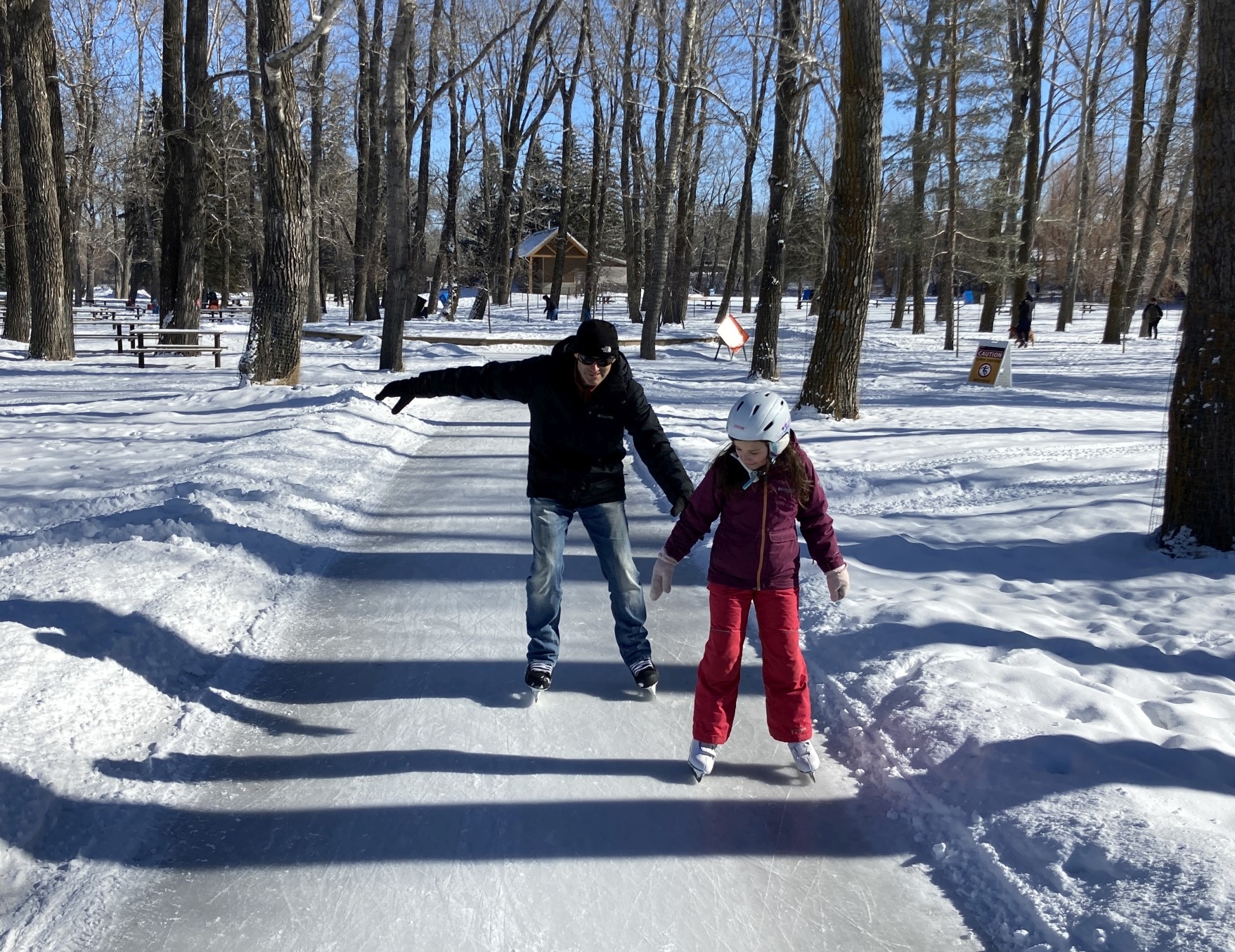
The second season of AWA’s Adventures for Wilderness got off to a great start with an afternoon of skating in Calgary’s Bowness Park. Adventure coordinator Sean Nichols tells the story:
Sitting around the firepit post-skate and crunching on s’mores, we remarked that the weather had turned out to be pretty much perfect. Weather is always top of mind for an event like this: too warm and the ice is slushy and treacherous; but too cold and everyone just ends up frozen, shivering, and not wanting to do anything.
As it happened, though, we couldn’t have asked for a better way to kick off the second season of the A4W program: Adventures for Wilderness 2021! Bright, sunny, calm, a few degrees below freezing, and with the previous night’s snowfall making the forests look fresh and magical.
Magical forests, indeed! In the heart of the city, Bowness Park features a recently-opened 1.6km ice trail winding its way through the trees lying in the Bow river valley, an enchanting setting ripe for exploration from family members of all ages, young and old; on skates and not.
After a quick tour of this “cool” pathway (sorry) and a few spins around the main lagoon, it was definitely time for those of us with shorter legs to return to the firepit and warm up with those s’mores, some hot chocolate, maybe a pepperoni stick or two, and a nice warm blanket.
Speaking of blankets, AWA’s Vivian Pharis was there too, and talked about her childhood growing up in northern BC, and about how they used to keep warm. With moccasins, sometimes several layers deep, stuffed into booties. She had some on-hand to pass around. I have to admit to feeling a bit envious of those with suck beautiful warm gear. After sitting around for a few hours in the early morning’s cold before the event, so that I could reserve the best firepit available, my feet were getting a touch numb!
There was time, as well, for those of us a bit too young to skate, to wander the forest paths in regular boots; so that they might also get a taste of the river valley, and perhaps a quick listen for the first of the spring’s birds calling out. Then, quickly, it seemed the day was over. The first event of this year’s A4W calendar… but for sure not the last!
We have many more events coming your way throughout the year — be sure to look through them to find one whose magic speaks to you too!
Cochrane & Lochend Areas Field Trip: Exploring Geology and the Impacts of Fracking
Written on October 28, 2020, by Sean Nichols
On October 9, Senior Petroleum Geologist Tako Koning led an expedition to the Cochrane and Lochend areas west of Calgary to explore the local magnificent glacial geology and also see a rapidly developing program of hydraulic fracking for oil in the area. He recounts:
Friday, October 9th began cloudy and cold but we had a bit of sunshine by the time the field trip began at 1:30 PM, with 14 attendees including 2 children, in the parking lot of Cochrane Ranche in Cochrane. We headed north for a short distance up 4th Avenue to the southern terminus of the Big Hill Springs glacial meltwater channel, a deeply incised valley which continues 20 km northwards. The field trip leader Tako Koning discussed the area’s glacial geology and Vivian Pharis talked about the efforts of the Bighill Creek Preservation Society to protect the unique flora and fauna along Bill Hill Creek which is located within rapidly growing Cochrane.
We proceeded to drive northeastwards and near Willow Creek, a community of acreages, we viewed from the road a pad with 7 pumpjacks which produce oil from the tight Cardium Formation sandstone. These wells consist of long-distance horizontal drain holes, drilled in multiple directions which have been hydraulically fractured. The oil production in the Lochend area has benefited the Alberta and local governments in terms of royalties and taxes and has created local oil field employment. However, in some cases the oil production has had worrisome environmental impacts for those living in nearby farms, acreages and homes.
We then stopped outside of the entrance to the Glendale gravel pit. The Cochrane – Lochend area has thick glacial deposits rich in gravel. Major gravel quarrying is increasingly being carried out throughout the area and some residents are very concerned about its impact on the area.
We also viewed a second well pad on the west side of Lochend Road where 4 wells produce from the hydraulically fractured Cardium. Howard Hawkwood, a farmer who has lived with his wife Nielle for forty years just east of Lochend Road (Highway 766), described to the group the negative impact of oil activities on their lives and on their farm. Heading northwards we saw another deeply incised melt water channel immediately south of the hamlet of Dog Pound. The field trip ended in the village of Westbrooke, located on Highway 22, also known as the Cowboy Trail, to view an oil production facility located on the eastern boundary of the village.
Witnessing Southern Alberta’s Fall Glory: A Hike up Lesueur Ridge
Written on October 28, 2020, by Sean Nichols
Heinz Unger recounts an early fall hike up Lesueur Ridge in the foothills just west of Calgary:
Lesueur Ridge is a steep sandstone ridge facing south overlooking the Ghost River Valley. It’s the first higher elevation feature when traveling from the Bow River through the foothills to the north. And it’s a short one-hour trip from NW Calgary to the trailhead where, on September 12, a small but diverse group met on a sunny but cool fall day. The ages of participants ranged from 12 to 76, and people clearly enjoyed meeting each other (some for the first time), and there were many good conversations during the hike. In addition to admiring the scenery and the local fauna and flora, the opportunity to meet, and converse with, old and new friends is one of the great pleasures of hiking with AWA.
Although the hike is rather short, there are some seriously steep sections that provide good excuses for brief stops to take in the increasingly far-reaching views and appreciate what was left of the summer’s wildflowers. The fall date was chosen to enhance the hike with fall colours which had just started to appear in their glory. Aspens, Black Poplars, willows, fireweed and various species of shrubs showed off in yellow and orange and red, in stark contrast with the dark and mighty Douglas fir trees that are quite common on and below the ridge.
Once the group reached the top of the ridge we stopped for a break to take in the view which ranges from downtown Calgary in the east to Black Rock Mountain and Devil’s Head in the northwest. Straight to the west were the high mountains of Banff National Park, and to the south, almost straight below us, were the winding channels of the North and South Ghost River. Close by, to the west, was Lesueur Creek, a tributary of the Ghost River, with its many wetlands created by beavers. A couple of ravens checked out the group, showed off their aerial acrobatics, and one of us responded with raven calls but otherwise is was beautifully quiet – close to a wilderness outing. We took a different trail down and walked out on the lower trail that runs along the creek, making it a beautiful loop hike. To round off the experience and let the good feelings linger, we still gathered for some refreshments and more talk at our place in Benchlands on Highway 40.
Considering the short distance from Calgary and the rather small effort and time needed to reach the top of the ridge, Lesueur Ridge is a worthwhile outdoor experience, especially when in support of AWA. I very much appreciate the generous support for AWA from all the participants, even those who could not make the actual hike.
Remembering Gus Yaki: a Ramble across Nose Hill
Written on October 7, 2020, by Sean Nichols
On October 3 AWA Executive Director Christyann Olson, and board member and Past President Vivian Pharis, led a walk over Nose Hill in memory of dear friend and naturalist Gus Yaki, who passed away earlier this year. They recount:
There was a cool wind blowing when we arrived at Nose Hill Park on Friday October 2, 2020. 0ur group was large; 29 folks eager to learn and to remember our dear friend Gus Yaki. Karel Bergmann, Tako Koning and Shawn Cornett helped Vivian and me make a fulsome ramble through some of the features of Calgary and Canada’s largest urban park that covers 11 square km.
We set off with a traditional land acknowledgement, then stopped at one of Gus’s favourite spots to teach about Balsam poplars and Aspen clones. While there Shawn Cornett told the story of community activism and the determination of those who had a vision for Nose Hill – that it needed to be protected as a park. She told of the struggles in earlier years to stave off developers and begin the administrative transformation to the much-used park it is today. She reminded us that not so long ago a request by the Winter Club to expand their parking lot required plenty of resistance to keep it from taking a piece of the park. One thing is certain, without community engagement and people like you being involved, this park remains vulnerable.
Our ramble continued to a string of sandstone boulders and a discussion with Tako Koning explaining the geology of the hill and where he pointed out fossil snails embedded in the boulders. As we moved along Karel and Vivian pointed out plants of interest as we made our way to a quartzite erratic the size of a bulldozer, that is a piece of Mt. Edith Cavell in Jasper. With its corners rubbed smooth by centuries of itchy bison, other parts of this rough erratic are covered with lichens. We scraped litter from under the boulder and added it to our litter bags, as we vowed to keep up Gus’s efforts at leaving no trace.
As we carried on we enjoyed stories about specific plants and debated about how they got where they did, about unusual land formations and boulders and shared dismay over invasive clematis and thistle that seems beyond control. Erosion in the main path needs repairs and we hope the City will do those repairs soon as they seem dangerously deep. Trail braiding and proliferation is an increasing problem all over the park. A north-south pathway led us toward the medicine wheel and through a lovely aspen grove filled with golden and orange leaves and the smell of fall.
As we neared the end of our ramble, we assembled at the Nose Hill Siksikaitsitapi Medicine Wheel where we formed a circle around the wheel to offer our thoughts about Gus and what he meant to us. We offered rose hips and dried cranberries to the spirits on entering the wheel from the east and before exiting to the west. The Blackfoot ceremonial elder who was interviewed years ago about this medicine wheel, spoke about it being a gift to the city and to the people who come to visit. He said, “they will know that somebody from the other side is looking out for them.”
Gus Yaki was remembered with joyful appreciation of the man who truly was a naturalist.
– Christyann and Vivian
Golden Larches and Spectacular Views: A Tryst Lake Hike
Written on September 24, 2020, by Sean Nichols
AWA Board Member, Secretary and Treasurer Chris Saunders lead an adventure to see the fall larches at Tryst Lake in the Kananaskis on September 20 2020 and writes of that trip here:
At about 10 am on September 20, 2020, 13 hikers assembled at a parking spot on the west side of the Spray River just off the road to Mount Shark, ready to start on the hike. The weather was warm and sunny and the smoke that had dominated the sky in the previous few days had suddenly cleared. The purpose was to see the alpine larch trees around the lake at a time of year when their needles change from green to a spectacular golden colour.
The hike was in 3 parts.
The first was 1.5 km south along an old logging road, which was likely created in the 1940’s or 1950’s. The route then turned west at a cairn following a stream through the forest up the side of the main valley to a small hanging valley in which Tryst Lake is located. Some larches, all in their glorious golden phase, were seen in the upper parts of this section. Lunch was taken by the lake. There were sightings of a family of hoary marmots nearby as well as magnificent views of the golden-coloured larches on the slopes on the south side of the lake.
After lunch the group walked to a moraine beyond the west end of the lake where there were fine views of the cliffs of The Fist towering over the cirque.
The third section of the hike involved a steep climb up a bank covered with grass and larch trees to the ridge on the south side of the lake. The path along the top of the ridge wound its way through groves of larches of many different ages, all a bright gold colour. In addition there were spectacular views of the lake below and the mountains to the south, including the majestic Mount Birdwood partially shrouded in cloud.
The group concluded this was a spectacular hike and we were lucky enough to do it in perfect conditions.

